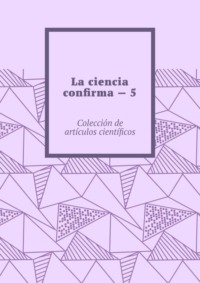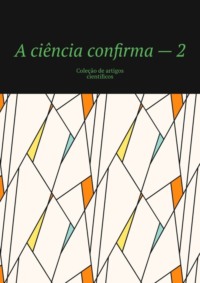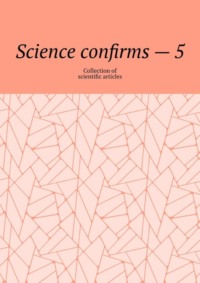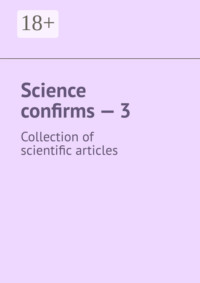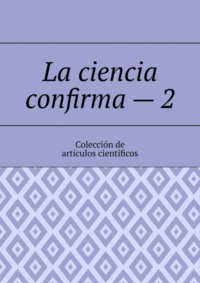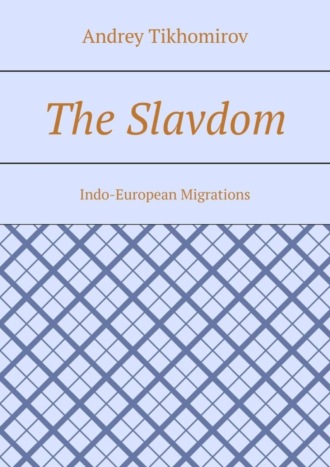
Полная версия
The Slavdom. Indo-European Migrations
In the Avesta, the god Ahura Mazda (an extremely knowledgeable priest) advises the legendary immaculate king of the ancient Aryans (Indo-Europeans) Yime to create a giant fence – Varu, and there, for this fence put “the seed of all the males and females that are greatest on this earth, and the seed of all genera cattle, and the seed of all plants. And to do everything in pairs, while people are in Var … " The legendary Vara consisted of 3 circles, enclosed one in another. From the extreme 9 passages were conducted, from the middle – 6, from the internal – 3. And on this territory fenced off from evil winds, Yima built 18 streets, and created a window above the top – something like a chimney for smoke. The patron of forging in the Slavic pagan pantheon was the blacksmith god Svarog (Sanskrit. “Svarga” – heaven). The image of Svarog is close to the Greek Hephaestus and Prometheus.
The sun – Yes-God – in Slavic mythology was thought of as the son of Svarog. The ancient Slavic god – Dazhdbog – the bearer of happiness, most likely symbolizes rain, for example, in Slovak dažď (read “dazhd”) – rain. “Wind is blowing” is an analogy with a man who blows from his mouth. “Blind rain” means – it is raining and the sun is shining, and thus it turns out that it is as if the rain “does not see” and goes where the sun is shining. In the Christian folk calendar, Svarog turned into saints Kozma and Demyan – patrons of blacksmithing and marriage. The very presence of the gods – the patrons of the forging – indicates the antiquity of its origin. With the word “Svarog” the word “Swastika” (Skt.) Is idiomatically similar – a cross with ends bent at right angles, one of the oldest ornamental motifs found among the peoples of India, China, Japan, where the swastika sign had religious significance. Compare also the Slavic words “cook”, “welding”. In the steppes of the Urals-Altai, forging has already reached significant development among the Scythian tribes of the Northern Black Sea region (7—4 centuries BC), as well as among the Sarmatians and Slavs, known in the 4th – 6th centuries. under the name of ants. In the 10—11 centuries. iron and steel products in Russia were widespread and had diverse applications. The ancient metallurgists usually concentrated in their hands both the smelting of iron from the swamp ore, the so-called “cooking” of iron, and the manufacture of various iron products, as well as the forging of copper, tin, silver and gold, especially in jewelry. A hearth was used where clods of swamp ore were covered with coal from below and above, which was ignited and heated to the desired temperature. The molten iron flowed to the bottom of the hearth and formed a viscous mass (crits). The blacksmith took it with pincers and then, forging it with a hammer on the anvil, gave the product the desired shape, knocked slags from the surface and reduced the porosity of the metal. The development of iron led to a significant leap in development. In addition, deposits of tin and copper, and their alloy of bronze, in the habitat of the ancient Indo-Europeans were practically absent, they were imported from other territories. Iron ores were more widespread than copper and tin, iron ores were formed in large quantities under the influence of microorganisms in swamps and stagnant water bodies. And the area of distribution of the ancient Indo-Europeans was precisely characterized by an abundance of lakes and wetlands. Unlike copper and tin, in ancient times iron was mined everywhere from brown iron ore, lake, swamp, and other ores. A prerequisite for the widespread use of iron metallurgy was the use of a raw-cheese process, in which the reduction of iron from ore was achieved at a temperature of 900 degrees, while iron was melted only at a temperature of 1530 degrees, to produce iron by a raw-iron method, the ore was crushed, calcined over an open fire, and then in pits or small clay foci, where charcoal was laid and air was blown by bellows, iron was restored. A scream formed at the bottom of the furnace (compare Krishna from Sanskrit, lit. – “dark, black”, one of the revered gods in Hinduism). – a lump of porous, pasty and heavily contaminated iron, which then had to be subjected to repeated hot forging. Screaming iron was notable for its softness, but already in ancient times a method was discovered for producing harder metal by hardening iron products or cementing them, that is, calcining in bone coal for the purpose of carbonization. The forge – furnace for the production of iron in the cheese-making process was a shallow hole in the ground, to which air from bellows was fed using clay tubes, which we observe in ancient reconstructions of Arkaim, Quintana, Goloring and other villages. Subsequently, these construction schemes began to be considered sacred and were reproduced in various cruciform variations, including in the form of a swastika, primitive domnica had the form of cylindrical structures made of stones or clay, narrowed upwards, hence the appearance of a swastika, a cross with ends bent at right angles. From below, channels were arranged where clay nozzle tubes were inserted, leather furs were attached to them, with their help air was pumped into the furnace. These designs resembled various types of crosses, which were later deified in Hinduism, Buddhism, Christianity.
The North Indian city of Varanasi (the name Var is mentioned in the name of the city, appeared around the 7th century BC), also known as Benares, is still the place of pilgrimage of the Hindus, there is also a mass cremation of the dead. The corpses of believers are burned in plain sight. In antiquity it was also in the vars: priests with horns on their heads and with wings behind their backs burned the dead people – that’s the prototype of hell. The deceased themselves wanted this, since it was believed that with fire they would immediately go to heaven to the gods.
The oldest books of the Veda and Avesta (compare: the Slavic words “to know” and “news”) are actually the primary basis for most of the religions that exist today. The oldest part of the Avesta Ghats are also called (Ghats) – mountains on the Hindustan Peninsula in India (Western and Eastern Ghats), as well as the old Russian word “ghat” – flooring made of logs for passage, passage through a swamp, swamp. Ghats – the steps of the embankment in Varanasi, descending to the Ganges, where the bodies of the dead are burned. All these words are of the same origin.
The cross was revered in pre-Christian cults. His images were discovered during archaeological excavations in different parts of the globe, in particular, in South America and New Zealand. It was established that he served as an object of worship of other nations as a symbol of fire, which was originally mined by the friction of two crossed sticks, a symbol of the sun and eternal life. Already in antiquity, in order to reduce the melting point of metallurgists, they began to use fluorites (fluorspar, fluorites come in different colors: violet, yellow, green, rarely colorless) and could receive steel at a temperature of 1100 – 1200 degrees, instead of 1530—1700 degrees, which allowed to spend less fuel (wood or coal) during steelmaking, getting very durable iron products.
According to “The Tale of Bygone Years”, Kiev was founded by the brothers Kiy, Schek and Horeb, and their sister Lybed. Kuyavia is a historical region in Poland, in the upper reaches of the Notets River and the middle reaches of the Vistula River, in the 1st millennium, the main population of Kuyavia was Kuyavians, from them the name of the region, Kuyavia is one of the Western Slavic tribal groups involved in the formation of the Polish nationality. Cuiabia or Kuyavia – the name of the city of Kiev in the Arabic sources of the X century (Ceyhani and others). The cheek is Czech (Czech. Čech, compare the pike to the Slovak. Šťuka, read “pike”), the legendary ancestor of the Czechs. Khoriv is Horvat (Croatian. “Horvat”, Polish. “Horvath”), the legendary ancestor of the Croats, the “white Croats” originally lived in the upper Dniester. Lybed (Ukrainian: “Lebed”, Belorussian. “Lebed”, Polish. “Łabędź”, Czech. “Labuť”) is a historical region in the southeast of modern Ukraine, where, perhaps, a woman bearing the totemic name Lebed, led the Slavic tribes, this area is mentioned in the Hungarian epos.
Конец ознакомительного фрагмента.
Текст предоставлен ООО «ЛитРес».
Прочитайте эту книгу целиком, купив полную легальную версию на ЛитРес.
Безопасно оплатить книгу можно банковской картой Visa, MasterCard, Maestro, со счета мобильного телефона, с платежного терминала, в салоне МТС или Связной, через PayPal, WebMoney, Яндекс.Деньги, QIWI Кошелек, бонусными картами или другим удобным Вам способом.




